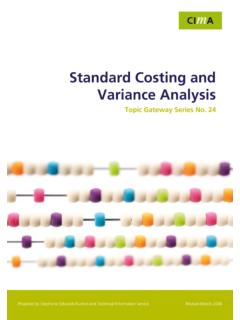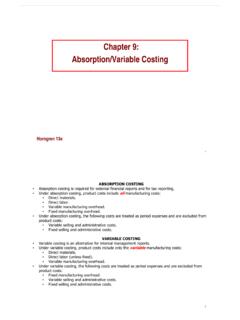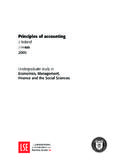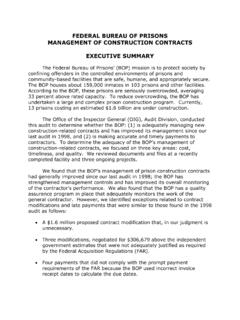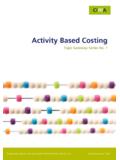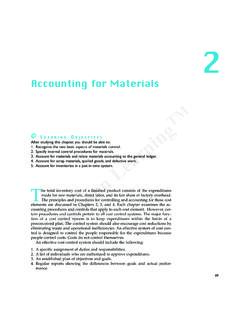Transcription of Educator Lesson Plan “Kitchen Calculations”
1 The Culinary Institute of America s Educator Lesson plan kitchen Calculations Menus used in the dining room give both the waitstaff and guests important information about what your establishment offers, and your recipes give detailed instructions to aid kitchen staff in producing those menu items. More importantly, carefully designed menu and comprehensive recipes can assist the professional chef in streamlining kitchen operations and controlling costs. The concepts explored in kitchen Calculations are powerful tools that will improve efficiency and organization.
2 We have designed each segment of the kitchen Calculations toolkit to help you and your staff overcome some of the more common kitchen math challenges that directly affect your bottom-line. Yield Percentage: Explore the various components of a yield test and learn how to identify the factors that might affect yield percentage. Cost Calculations: Discover one of the most important elements in budgeting and predicting your finances. Edible Portion Cost: Learn how cost affects purchasing and your recipe.
3 Recipe costing : Uncover the importance of costing skills that will lead to greater profit in your operation. 2 YIELD PERCENTAGE Yield Percent is a vital tool for determining how much of a product to purchase or used in a recipe. Calculating yield percentage is critical to placing an accurate food order. Improperly calculating your food order can result in having too much or too little of a given ingredient. Too much of an ingredient will put you in the situation of scrambling to create a new dish to entice your customers and use your excess product.
4 On the flip-side, running short of an item or ingredient can only lead to disappointment for customers longing for your new "signature dish." Determining the Yield Percentage of your recipes in advance will lead to greater efficiencies and a more productive operation. By utilizing the following formulas and tips, you and your staff will lower your food costs and create a healthier bottom-line. As-Purchased Quantity (APQ): The weight, volume, or count of the product as it is received from the vendor. The cost of 50# bag of potatoes, before fabrication, is the as-purchased quantity or APQ.
5 Edible Portion Quantity (EPQ): The weight, volume, or count of the product after it has been cleaned, peeled, or prepared (fabricated) and is ready for use. The word edible signifies the condition of the product as ready for use in the dish you are going to prepare within your operation. Trim: The weight or volume of the waste. This factor can be determined mathematically as the difference between APQ and EPQ. APQ EPQ = Trim Example: The edible portion of a cleaned bag of 50# of potatoes would be the EPQ and would weigh in at approximately pounds.
6 50 lbs lbs = lbs (trim) Tip: Not all trim is loss; if the trim is usable, then it is not loss. For example, if the potato peels can be used in a vegetable stock for soup, they would not be considered trim. Utilizing the trim will make a kitchen run more cost-effectively; however, the value of the skins may be so small that it might not be worth allocating this cost to the ultimate recipe. 3 Yield Percentage: The percentage of the as-purchased quantity that is edible. There are three major applications for yield percentage.
7 1. Computing the minimum amount to order 2. Recipe costing 3. Determining the maximum number of servings that a purchased amount will yield Yield Percentage Formula = Edible Portion Quantity/As-Purchased Quantity x 100 Example: Your operation has purchased 50 pounds of potatoes. Upon cleaning and peeling, there are pounds remaining and pounds of trim. We will use the 3-Step Process to Calculate Yield Percentage. 1. Identify the EPQ and APQ APQ = 50 pounds (whole potatoes) EPQ = pounds (cleaned and peeled potatoes) 2.
8 Determine if the units are the same before calculating the yield percentage Both the APQ and EPQ are in pounds - if not, use the Bridge Method to calculate the units uniformly. For example: Converting teaspoons to tablespoons: 12 tsp/1 x 1 tbsp/3 tsp = 12/3 or 4 tablespoons Converting tablespoons to cups: 12 tsp/1 x 1 tbsp/3 tsp = 12/3 or 4 tablespoons 4 tbsp/1 x 1 cup/16 tbsp = 4/16 = .25 cups or cup The Bridge Method results in 12 teaspoons or cup 3. Substitute the weights of the EPQ and APQ into the following formula Yield Percentage = EPQ/APQ or pounds/50 pounds =.
9 85*100 = 85% 4 Tip: Certain conditions may affect your yield percentage: An employee s skill in cleaning the product will have an enormous effect on the yield percentage skilled employees will not create as much waste The size of the product also has an effect on the yield percentage cleaning smaller carrots will create more waste and a lower yield percentage The condition of the product has an effect on the yield if your operation is not using the freshest products available, the yield percentage will be lower Example.
10 Steps for an Actual Yield Percentage Carrots are used in the following example, but the same procedure holds true for all fruits and vegetables. 1. Purchase carrots 2. Weigh the carrots (APQ) 3. Clean the carrots (peel & trim ends) 4. Weigh the clean carrots (EPQ) 5. Using the APQ & EPQ weights, calculate the yield percentage using the Yield Percentage formula: Yield Percentage = EPQ/APQ Yield percentage is an extremely useful tool. However, in reality, there may not always be sufficient time to do an actual yield test.



